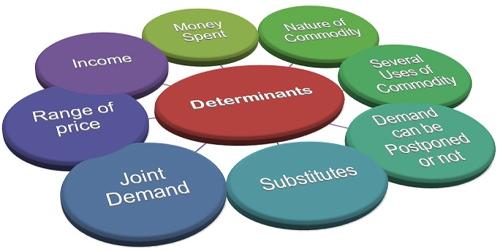Determinants of Elasticity of Demand
A good with more close substitutes will likely have a higher elasticity. The higher the percentage of a consumer’s income used to pay for the product, the higher the elasticity tends to be. For non-durable goods, the longer a price change holds, the higher the elasticity is likely to be.
The elasticity of demand of any commodity is determined by a number of factors which are explained below:
Nature of commodity
The elasticity demand for any commodity depends upon the nature of the commodity, i.e., whether it is a necessity, comfort or luxury. The elasticity of demand for any commodity depends upon the nature of the commodity i.e. whether it is a necessity, comfort, or luxury. The demand for comfort products have neither very elastic nor very inelastic because with the rise or fall in their prices, the demand for them decrease or increase moderately. On the other hand, the demand for luxuries goods is more elastic, because, with a small change in their prices, there is a large change in the demand.
Substitutes
Commodities having substitutes have more elastic demand because with the change in the price of one commodity, the demand for its substitute is immediately affected. For example, if the price of coffee rises, the demand for coffee decreases and the demand for tea increases and vice-versa.
Goods having several uses
If a commodity has several uses, it has an elastic demand. For example, electricity has several uses. It is used for lighting, room heating, cooking, etc. if the tariffs of electricity increase, its uses will be restricted to important uses. If the tariffs of electricity increases, its uses will be restricted to important uses. On the other hand, it will be withdrawn for less important uses.

Joint demand
The elasticity of demand also depends on the complementary goods, the goods which are used jointly. Such as car and petrol, pen and ink, etc. Here the elasticity of demand of secondary (supporting) commodity depends on the elasticity of demand of the major commodity. On the other hand, if the demand for bread is elastic, the demand for jam will also be elastic.
Postpone of the consumption
Those commodities whose consumption can be postponed will be elastic. For example, demand for constructing a house can be postponed. As a result, demand for bricks, cement, sand etc will be elastic. On the other hand, goods whose demand cannot be postponed, their demand will be inelastic.
Habits
People who are habituated to the consumption of a particular commodity like coffee, tea, cigarette of a particular brand, the demand for it will be inelastic.
Income of the consumer
The elasticity of demand also depends on income of the consumer. If the income of consumers is high, the elasticity of demand is less elastic. It is because change in the price will not affect the quantity demanded by a greater proportion. But in low income groups, the elasticity of demand is elastic. Because a rise or fall in the price of commodities will reduce or increase the demand. But this does not apply in the case of necessities.
Proportion of income spent
Goods on which a consumer spends a very small proportion of his income, e.g. salt, newspaper, tooth paste etc. the demand will nor be much affected by a change in the price. Hence, it will be inelastic. On the other hand, goods on which the consumer spends a large proportion of his income e.g clothes, food etc. their demand will be elastic.
Price level
The price level also influences the elasticity of demand for commodities. When price level is too high or too low, the demand will be comparatively inelastic.
Information Source:
















